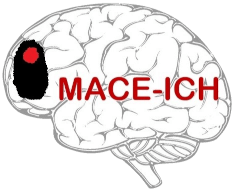| Title |
MAnnitol for Cerebral oEdema
after IntraCerebral Haemorrhage (MACE-ICH)
|
| Acronym |
MACE-ICH
|
| Chief investigator |
Dr Kailash Krishnan
|
| Objectives |
To determine the feasibility of screening, assessing eligibility,
approaching potential participants, randomisation, administering mannitol
and completing follow-up for acute haemorrhagic stroke patients with
cerebral oedema, or at risk of cerebral oedema, to inform a definitive
trial.
To determine the feasibility and inform the design and conduct of an
adequately powered, pragmatic, prospective multi-centre RCT testing
mannitol as a treatment for cerebral oedema in spontaneous ICH.
|
| Trial configuration |
A multicentre, prospective, randomised, open-label, blinded-endpoint
trial.
|
| Setting |
Ten UK, NHS hospitals providing acute stroke services.
|
| Sample size estimate |
This is a feasibility trial so there is no formal sample size
calculation. It is likely that a planned target of 45 participants
with high rates of adherence to treatment and follow-up data would inform
a definite trial. Lower recruitment would not preclude progression
if there is evidence that barriers to recruitment could be overcome.
|
| Number of participants |
45
|
| Eligibility criteria |
Inclusions
-
Adults aged 18 and above
-
Spontaneous ICH confirmed by CT scan with estimated largest
diameter over 2 cm
-
Within 72 hours of ictus (or from last seen healthy)
-
Cerebral oedema with or without evidence of mass effect at baseline
or subsequent scanning
-
At risk of developing cerebral oedema
- limited GCS score less than 9 (eye opening and motor only) and
- NIHSS total of 8 or above
-
Signed consent – patient, personal or professional
legal representative
Exclusions
-
GCS less than 5
-
Premorbid mRS of 4 or 5
-
Isolated subarachnoid haemorrhage
-
Haemorrhage known to be from: trauma or venous thrombosis or
arteriovenous malformation or brain tumour or transformation of
cerebral infarct or cerebral aneurysm or thrombolytic drug
-
Known hypersensitivity to mannitol
-
Severe renal failure (e-GFR under 30ml/min or dialysis)
-
Cardiac failure
-
Hypotension at baseline (systolic BP under 90 mm/Hg)
-
Anuria
-
Patient unwilling to participate
-
Geographical or other factors which prohibit follow-up
-
Pre-existing comorbidity with pre-ictal life expectancy under
6 months
-
Severe dementia
-
Planned for palliative care
-
Severe hypernatraemia (sodium over 160 mmol)
-
Severe hyponatraemia (sodium under 125 mmol)
-
Women of child-bearing potential with a positive pregnancy test at
the time of admission or lactating
-
Patients in whom peripheral intravenous cannula cannot be placed
-
Planned neurosurgery
|
| Description of interventions |
- 1 g/kg 10% single dose mannitol infusion at 10 ml/min, in
addition to standard care.
- 1 g/kg 10% mannitol at 10 ml/min
followed by a second dose 1 g/kg repeated at 24 hours, if the serum
osmolality is under 320 mOsm/kg and sodium under 160 mEq/L after the
first dose, in addition to standard care.
- Standard care
only.
|
| Duration of study |
Follow-up duration: 6 months from enrolment.
Planned trial period: 24 months.
|
| Randomisation and blinding |
Randomisation will be to one dose of mannitol vs two doses of mannitol vs
standard care in a 1:1:1 ratio.
Randomisation will be performed by the stroke trials unit (STU),
University of Nottingham, with computerised minimisation on key
prognostic factors: age, limited GCS, time from stroke onset and largest
haemorrhage diameter.
Outcome assessors will be masked to treatment allocation.
|
| Outcome measures |
Feasibility outcomes (primary outcomes)- Number of patients:
screened and eligible
- Number of eligible patients recruited and
reasons for not recruiting
- Proportion of eligible participants
who received allocated treatment and reasons for
non-allocation
- Recruitment rate
- Treatment
adherence
- Retention rate
- Number of participants with
outcome data and reasons for non-availability
- Effectiveness of
blinded follow-up
- Incidence and type of adverse events, protocol
violations and trial withdrawal
Secondary
outcomes- Laboratory (day
1-2)
- U+Es
- e-GFR
- Serum osmolality to correlate
response to mannitol
- Glasgow Coma Scale (GCS) (day
5±2 days)
- NIH Stroke Scale (NIHSS) (day 5±2
days)
- Number of participants who had urinary tract infection (day
5±2 days, day 28)
- Number of participants who had sepsis
(day 5±2 days, day 28)
- Mortality (day 5±2 days, day
28)
- Disability (Barthel Index, day 180)
- Mood (Zung
depression scale [ZDS], day 180)
- Cognition (TICS-M day
180)
- Quality of life (EQ-5D; EQ-VAS, day 180)
- Health
economic assessment (EQ-5D, day 180)
- Death or dependency
(modified Rankin scale, day 180)
- Length of stay (day
180)
- Discharge destination (day 180)
- Long-term outcomes
post COVID-19 and ICH (day 180)
- Number of participants who were
transferred to high dependency unit
- Number of participants
needing high dependency or intensive care unit
- Number of
participants undergoing neurosurgical intervention
- Recurrent
stroke
- Number of participants intubated and
ventilated
- Mechanistic
- Follow-up CT scan to assess changes
in oedema volume, oedema extension distance, haematoma volume, midline
shift, hydrocephalus (day 5±2 days)
Safety
outcomes- Death
- Thrombophlebitis
- Hypernatremia/hyponatremia
- Pulmonary
oedema
- Hypotension
- Renal impairment
- Serious
Adverse Events until day 180
|
| Statistical methods |
Analysis will primarily be descriptive to address the feasibility
objectives of the trial. A full statistical analysis plan (SAP)
will be finalised prior to database lock.
|

